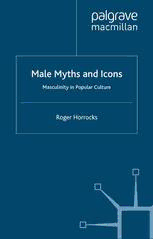
Male Myths and Icons: Masculinity in Popular Culture PDF
Preview Male Myths and Icons: Masculinity in Popular Culture
MALE MYTHS AND ICONS By the same author MASCULINITY IN CRISIS: Myths, Fantasies and Realities Male Myths and Icons Masculinity in Popular Culture Roger Horrocks Consultant Editor Jo Campling ~ MACMILLAN ©Roger Horrocks 1995 All rights reserved. No reproduction, copy or transmission of this publication may be made without written permission. No paragraph of this publication may be reproduced, copied or transmitted save with written permission or in accordance with the provisions of the Copyright, Designs and Patents Act 1988, or under the terms of any licence permitting limited copying issued by the Copyright Licensing Agency, 90 Tottenham Court Road, London WlP 9HE. Any person who does any unauthorised act in relation to this publication may be liable to criminal prosecution and civil claims for damages. First published 1995 by MACMILLAN PRESS LTD Houndmills, Basingstoke, Hampshire RG21 6XS and London Companies and representatives throughout the world ISBN 978-0-333-61699-4 ISBN 978-0-230-38939-7 (eBook) DOI10.1057/9780230389397 A catalogue record for this book is available from the British Library. 10 9 8 7 6 5 4 3 2 I 04 03 02 01 00 99 98 97 96 95 For Adam 'Signs are small measurable things, but their interpretation is illimitable.' George Eliot, Middlemarch Contents Acknowledgements VIll 1 Introduction 1 2 Approaches to Gender 6 3 Studying Popular Culture 22 4 Psychological Approaches to Culture 35 5 Westerns 56 6 Horror Films 83 7 Pornography 101 8 Male Images in Rock and Pop Music 126 9 Male Sport 147 10 Conclusions 170 Notes . 179 Index o/Texts Cited 194 General Index 198 vii Acknowledgements Warm thanks go to Jo Campling, who helped me to give shape to this book; and also to Annabelle Buckley, my editor, who has been unfailingly helpful. I am indebted to the anonymous reviewer, who helped me improve many sections. Since I am not an academic, I am particularly reliant on various insti tutions and libraries for supplying me with material: in particular, I thank staff of the British Film Institute; the Independent Television Commission; the Sports Council, London; the Central Music Library, Westminster; the Samaritans; and the Library, University College London. Several people have listened to me tirelessly, as I struggled to articulate the ideas in this book: specifically, I am very grateful to Sybilla Madigan and Judith Hemming. My friend Victoria Zinovieff has been just that, and has helped me enormously. I can never thank Rachel enough for being there, and for helping me grasp concretely how men and women can live together in a spirit of equality and harmony. A special thanks to my son Adam for all the hockey games we've played, the horror films we watched together, and the Metallica tapes he lent me. ROGER HORROCKS viii 1 Introduction This book sets out to analyze some images of men, and some images used by men, in popular culture. I have chosen to look at popular culture in the belief that such forms as the horror film, the western novel and film, rock and pop music, and sport, give interesting insights into the themes and contradictions in the masculine gender. I see popular culture to some extent as dream-like, naive, not censored by a more sophisticated intellectual understanding. It is full of images that seem archetypal, primitive, welling up from the depths of the psyche. For example the horror film exists because people want to see images that frighten them and horrify them, yet also permit them some cathartic relief from their nightmarish fantasies. The horror film maker may develop very sophisticated ideas about his craft, but unless he sticks to the images that touch a chord in people, he will fail. Thus, just as dreams can be used to gain insight into areas of the psyche that we are unwilling or unable to penetrate consciously, so popular images can be used to investigate collective unconscious attitudes and feelings. At the same time, popular culture seems to relay political ideas very quickly, and can be seen as an arena where certain political struggles are contested. Hollywood, for example, has portrayed the rising self confidence of women, the male backlash against this, and at times the 'gender war' that results.! Thus, popular culture can be analyzed psychologically or politically. I shall endeavour to do both, since one without the other strikes me as quite imbalanced. Popular art forms are also interesting in themselves, because they have a high degree of energy, an aesthetic quality that may lack finesse but pro vides something satisfying in its own way. There is something valuable and pleasurable in 'reclaiming' areas of culture that were formerly dis dained or simply ignored. One might superficially assume that popular images of masculinity would be unfailingly of the Rambo type - giving us a picture of ultra machismo - but this is far from the truth. Indeed popular art is filled with contradictory images that reflect the tensions and ambivalences of masculinity. In fact, Rambo himself may not be as coherent an image of manliness as some critics have assumed.2
